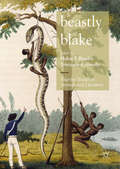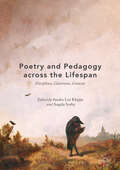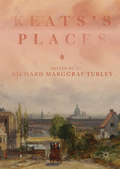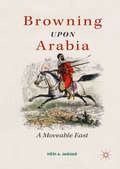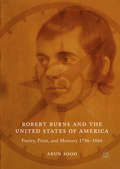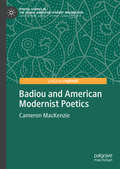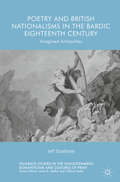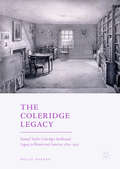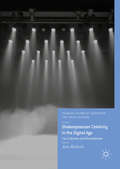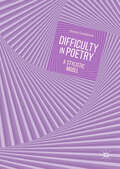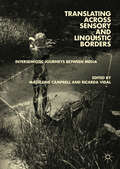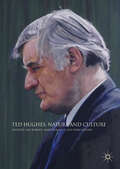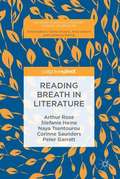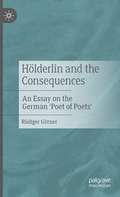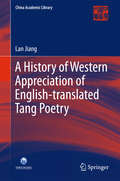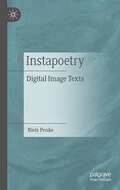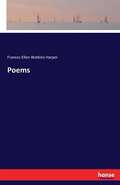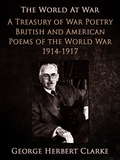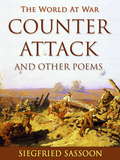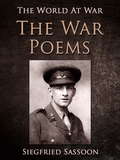- Table View
- List View
Beastly Blake (Palgrave Studies in Animals and Literature)
by Helen P. Bruder Tristanne ConnollyBlake’s ‘Human Form Divine’ has long commanded the spotlight. Beastly Blake shifts focus to the non-human creatures who populate Blake’s poetry and designs. The author of ‘The Tyger’ and ‘The Lamb’ was equally struck by the ‘beastliness’ and the beauty of the animal kingdom, the utter otherness of animal subjectivity and the meaningful relationships between humans and other creatures. ‘Conversing with the Animal forms of wisdom night & day’, Blake fathomed how much they have to teach us about creation and eternity. This collection ranges from real animals in Blake’s surroundings, to symbolic creatures in his mythology, to animal presences in his illustrations of Virgil, Dante, Hayley, and Stedman. It makes a third to follow Queer Blake and Sexy Blake in irreverently illuminating blind spots in Blake criticism. Beastly Blake will reward lovers of Blake’s writing and visual art, as well as those interested in Romanticism and animal studies.
Poetry and Pedagogy across the Lifespan: Disciplines, Classrooms, Contexts
by Sandra Lee Kleppe Angela SorbyThis book explores poetry and pedagogy in practice across the lifespan. Poetry is directly linked to improved literacy, creativity, personal development, emotional intelligence, complex analytical thinking and social interaction: all skills that are crucial in contemporary educational systems. However, a narrow focus on STEM subjects at the expense of the humanities has led educators to deprioritize poetry and to overlook its interdisciplinary, multi-modal potential. The editors and contributors argue that poetry is not a luxury, but a way to stimulate linguistic experiences that are formally rich and cognitively challenging. To learn through poetry is not just to access information differently, but also to forge new and different connections that can serve as reflective tools for lifelong learning. This interdisciplinary book will be of value to teachers and students of poetry, as well as scholars interested in literacy across the disciplines.
Keats's Places
by Richard Marggraf TurleyAs the essays in this volume reveal, Keats’s places could be comforting, familiar, grounding sites, but they were also shifting, uncanny, paradoxical spaces where the geographical comes into tension with the familial, the touristic with the medical, the metropolitan with the archipelagic. Collectively, the chapters in Keats’s Places range from the claustrophobic stands of Guy’s Hospital operating theatre to the boneshaking interior of the Southampton mail coach; from Highland crags to Hampstead Heath; from crowded city interiors to leafy suburban lanes. Offering new insights into the complex registrations of place and the poetic imagination, the contributors to this book explore how the significant places in John Keats’s life helped to shape an authorial identity.
Keats's Places
by Richard Marggraf TurleyAs the essays in this volume reveal, Keats’s places could be comforting, familiar, grounding sites, but they were also shifting, uncanny, paradoxical spaces where the geographical comes into tension with the familial, the touristic with the medical, the metropolitan with the archipelagic. Collectively, the chapters in Keats’s Places range from the claustrophobic stands of Guy’s Hospital operating theatre to the boneshaking interior of the Southampton mail coach; from Highland crags to Hampstead Heath; from crowded city interiors to leafy suburban lanes. Offering new insights into the complex registrations of place and the poetic imagination, the contributors to this book explore how the significant places in John Keats’s life helped to shape an authorial identity.
Browning Upon Arabia: A Moveable East
by Hédi A. JaouadBrowning Upon Arabia charts Robert Browning’s early and enduring engagement with the East, particularly the Arab East. This book highlights the complexities of Browning’s poetry, revealing Browning’s resistance to triumphalist and imperialist forms of Orientalism generated by many nineteenth-century British and European literary and scholarly portrayals of the East. Hédi A. Jaouad argues that Browning extensively researched the literature, history, philosophy, and culture of the East to produce poetry that is sensitive to its Eastern resources and devoted to confirming the interrelation of Northern and Eastern knowledge in pursuit of a new form of transcendental humanism.
Browning Upon Arabia: A Moveable East
by Hédi A. JaouadBrowning Upon Arabia charts Robert Browning’s early and enduring engagement with the East, particularly the Arab East. This book highlights the complexities of Browning’s poetry, revealing Browning’s resistance to triumphalist and imperialist forms of Orientalism generated by many nineteenth-century British and European literary and scholarly portrayals of the East. Hédi A. Jaouad argues that Browning extensively researched the literature, history, philosophy, and culture of the East to produce poetry that is sensitive to its Eastern resources and devoted to confirming the interrelation of Northern and Eastern knowledge in pursuit of a new form of transcendental humanism.
Robert Burns and the United States of America: Poetry, Print, and Memory 1786–1866
by Arun SoodThis book provides a critical study of the relationship between Robert Burns and the United States of America, c.1786-1866. Though Burns is commonly referred to as Scotland’s “National Poet”, his works were frequently reprinted in New York and Philadelphia; his verse mimicked by an emerging canon of American poets; and his songs appropriated by both abolitionists and Confederate soldiers during the Civil War era. Adopting a transnational, Atlantic Studies perspective that shifts emphasis from Burns as national poet to transnational icon, this book charts the reception, dissemination and cultural memory of Burns and his works in the United States up to 1866.
Robert Burns and the United States of America: Poetry, Print, and Memory 1786–1866
by Arun SoodThis book provides a critical study of the relationship between Robert Burns and the United States of America, c.1786-1866. Though Burns is commonly referred to as Scotland’s “National Poet”, his works were frequently reprinted in New York and Philadelphia; his verse mimicked by an emerging canon of American poets; and his songs appropriated by both abolitionists and Confederate soldiers during the Civil War era. Adopting a transnational, Atlantic Studies perspective that shifts emphasis from Burns as national poet to transnational icon, this book charts the reception, dissemination and cultural memory of Burns and his works in the United States up to 1866.
Badiou and American Modernist Poetics (Pivotal Studies in the Global American Literary Imagination)
by Cameron MacKenzieBadiou and American Modernist Poetics explores the correspondence between Alain Badiou's thinking on art and that of the canonical modernists T.S. Eliot, Wallace Stevens, and Ezra Pound. Utilizing a multidisciplinary approach, the text engages with themes of the void, mastery, and place present in both modernist poetry and in Badiou’s philosophy. Through an examination of classic modernist texts, Cameron MacKenzie reveals that where Badiou hopes to go, the modernists have already been.
Badiou and American Modernist Poetics (Pivotal Studies in the Global American Literary Imagination)
by Cameron MacKenzieBadiou and American Modernist Poetics explores the correspondence between Alain Badiou's thinking on art and that of the canonical modernists T.S. Eliot, Wallace Stevens, and Ezra Pound. Utilizing a multidisciplinary approach, the text engages with themes of the void, mastery, and place present in both modernist poetry and in Badiou’s philosophy. Through an examination of classic modernist texts, Cameron MacKenzie reveals that where Badiou hopes to go, the modernists have already been.
Poetry and British Nationalisms in the Bardic Eighteenth Century: Imagined Antiquities (Palgrave Studies in the Enlightenment, Romanticism and Cultures of Print)
by Jeff StraboneThis book offers a radical new theory of the role of poetry in the rise of cultural nationalism. With equal attention to England, Scotland, and Wales, the book takes an Archipelagic approach to the study of poetics, print media, and medievalism in the rise of British Romanticism. It tells the story of how poets and antiquarian editors in the British nations rediscovered forgotten archaic poetic texts and repurposed them as the foundation of a new concept of the nation, now imagined as a primarily cultural formation. It also draws on legal and ecclesiastical history in drawing a sharp contrast between early modern and Romantic antiquarianisms. Equally a work of literary criticism and history, the book offers provocative new theorizations of nationalism and Romanticism and new readings of major British poets, including Allan Ramsay, Thomas Gray, and Samuel Taylor Coleridge.
The Coleridge Legacy: Samuel Taylor Coleridge's Intellectual Legacy in Britain and America, 1834–1934
by Philip AherneThis book examines the development of Samuel Taylor Coleridge’s intellectual legacy in Britain and America from 1834 to 1934 by focusing on his late role as the Sage of Highgate and his programme of educating young minds who were destined for the higher professions (particularly preaching and teaching). Chapters assess his pedagogy and his late publications, his posthumous reputation, and his influence on aesthetics, theology, philosophy, politics and social reform. The book discusses a wide range of British and American intellectuals, including Thomas and Matthew Arnold, F. D. Maurice, John Stuart Mill, Henry Sidgwick, Shadworth Hodgson, T. H. Green, James Marsh, Ralph Waldo Emerson, Horace Bushnell, William James and John Dewey. It demonstrates how Coleridgean ideas were developed and distorted into something he would never have recognized as his own and emphasizes his significance as a catalyst who played a vital role in shaping the intellectual vocation of the long nineteenth century.
Shakespearean Celebrity in the Digital Age: Fan Cultures and Remediation (Palgrave Studies in Adaptation and Visual Culture)
by Anna BlackwellThis book offers a timely examination of the relationship between Shakespeare and contemporary digital media. By focusing upon a variety of ‘Shakespearean’ individuals, groups and communities and their ‘online’ presence, the book explores the role of popular internet culture in the ongoing adaptation of Shakespeare’s plays and his general cultural standing. The description of certain performers as ‘Shakespearean’ is a ubiquitous but often throwaway assessment. However, a study of ‘Shakespearean’ actors within a broader cultural context reveals much, not only about the mutable face of British culture (popular and ‘highbrow’) but also about national identity and commerce. These performers share an online space with the other major focus of the book: the fans and digital content creators whose engagement with the Shakespearean marks them out as more than just audiences and consumers; they become producers and critics. Ultimately, Digital Shakespeareans moves beyond the theatrical history focus of related works to consider the role of digital culture and technology in shaping Shakespeare’s contemporary adaptive legacy and the means by which we engage with it.
Shakespearean Celebrity in the Digital Age: Fan Cultures and Remediation (Palgrave Studies in Adaptation and Visual Culture)
by Anna BlackwellThis book offers a timely examination of the relationship between Shakespeare and contemporary digital media. By focusing upon a variety of ‘Shakespearean’ individuals, groups and communities and their ‘online’ presence, the book explores the role of popular internet culture in the ongoing adaptation of Shakespeare’s plays and his general cultural standing. The description of certain performers as ‘Shakespearean’ is a ubiquitous but often throwaway assessment. However, a study of ‘Shakespearean’ actors within a broader cultural context reveals much, not only about the mutable face of British culture (popular and ‘highbrow’) but also about national identity and commerce. These performers share an online space with the other major focus of the book: the fans and digital content creators whose engagement with the Shakespearean marks them out as more than just audiences and consumers; they become producers and critics. Ultimately, Digital Shakespeareans moves beyond the theatrical history focus of related works to consider the role of digital culture and technology in shaping Shakespeare’s contemporary adaptive legacy and the means by which we engage with it.
Difficulty in Poetry: A Stylistic Model
by Davide CastiglioneThis book theoretically defines and linguistically analyses the popular notion that poetry is ‘difficult’ - hard to read, hard to understand, hard to engage with. It is the first work to offer a stylistic and cognitive model that sheds new light on the mechanisms of difficulty, as well as on its range of potential effects. Its eight chapters are organised into two thematic parts. The first traces the history of difficulty, surveys its main scholarly traditions, addresses related themes – from elitism to obscurity, from abstraction to intentionality – and introduces a wide array of analytical tools from literary theory and cognitive psychology. These tools are then consistently applied in the second part, which includes several extended analyses of poems by canonical modernists such as Ezra Pound, Wallace Stevens and Hart Crane, alongside those of postmodernist innovators such as Geoffrey Hill, Susan Howe and Charles Bernstein, among others. This innovative work will provide fresh insights and approaches for scholars of stylistics, literary studies, cognitive poetics and psychology.
Translating across Sensory and Linguistic Borders: Intersemiotic Journeys between Media
by Ricarda Vidal Madeleine CampbellThis book analyses intersemiotic translation, where the translator works across sign systems and cultural boundaries. Challenging Roman Jakobson’s seminal definitions, it examines how a poem may be expressed as dance, a short story as an olfactory experience, or a film as a painting. This emergent process opens up a myriad of synaesthetic possibilities for both translator and target audience to experience form and sense beyond the limitations of words. The editors draw together theoretical and creative contributions from translators, artists, performers, academics and curators who have explored intersemiotic translation in their practice. The contributions offer a practitioner’s perspective on this rapidly evolving, interdisciplinary field which spans semiotics, cognitive poetics, psychoanalysis and transformative learning theory. The book underlines the intermedial and multimodal nature of perception and expression, where semiotic boundaries are considered fluid and heuristic rather than ontological. It will be of particular interest to practitioners, scholars and students of modern foreign languages, linguistics, literary and cultural studies, interdisciplinary humanities, visual arts, theatre and the performing arts.
Ted Hughes, Nature and Culture
by Neil Roberts Mark Wormald Terry GiffordThe fourteen contributors to this new collection of essays begin with Ted Hughes’s proposition that ‘every child is nature’s chance to correct culture’s error.’ Established Hughes scholars alongside new voices draw on a range of approaches to explore the intricate relationships between the natural world and cultural environments — political, as well as geographical — which his work unsettles. Combining close readings of his encounters with animals and places, and explorations of the poets who influenced him, these essays reveal Ted Hughes as a writer we still urgently need. Hughes helps us manage, in his words, ‘the powers of the inner world and the stubborn conditions of the other world, under which ordinary men and women have to live’.
Reading Breath in Literature (Palgrave Studies in Literature, Science and Medicine)
by Arthur Rose Stefanie Heine Naya Tsentourou Corinne Saunders Peter GarrattThis open access book presents five different approaches to reading breath in literature, in response to texts from a range of historical, geographical and cultural environments. Breath, for all its ubiquity in literary texts, has received little attention as a transhistorical literary device. Drawing together scholars of Medieval Romance, Early Modern Drama, Fin de Siècle Aesthetics, American Poetics and the Postcolonial Novel, this book offers the first transhistorical study of breath in literature. At the same time, it shows how the study of breath in literature can contribute to recent developments in the Medical Humanities.
Hölderlin and the Consequences: An Essay on the German 'Poet of Poets'
by Rüdiger Görner"A sign we are, uninterpreted. Painless we are and have almost / lost the language in a foreign country." Thus begins the second version of Friedrich Hölderlin's hymn dedicated to goddess of memory, Mnemosyne. "Hölderlin and the Consequences" wants to remember this 'poet of poets' and consider what his unmatched poems have stimulated, even triggered, in others. This scholarly essay examines the legacy of a poet who was, by and large, ostracized in his time, a master of language, who was declared a stranger by his contemporaries until he became a stranger to himself. Hölderlin's multiple experience of foreignness and alienation was later counteracted by often ideologically motivated attempts to appropriate him. Rüdiger Görner presents this complex context as a special case in recent literary history.This book is a translation of an original German 1st edition, "Hölderlin und die Folgen" by Rüdiger Görner, published by J.B. Metzler, imprint of Springer-Verlag GmbH Germany, part of Springer Nature in 2016. The translation was done with the help of artificial intelligence (machine translation by the service DeepL.com). The author (with the support of Josh Torabi) has subsequently revised the text further in an endeavour to refine the work stylistically.
A History of Western Appreciation of English-translated Tang Poetry (China Academic Library)
by Lan JiangThis book examines the development of English-translated Tang poetry and its propagation to the Western world. It consists of two parts, the first of which addresses the initial stage of English-translated Tang poetry’s propagation, and the second exploring its further development. By analyzing the historical background and characteristics of these two stages, the book traces the trend back to its roots, discusses some well-known early sinologists and their contributions, and familiarizes readers with the general course of Tang poetry’s development. In addition, it presents the translated versions of many Tang poems.The dissemination of Tang poetry to the Western world is a significant event in the history of cross-cultural communication. From the simple imitation of poetic techniques to the acceptance and identification of key poetic concepts, the Tang poetry translators gradually constructed a classic “Chinese style” in modern American poetry. Hence, the traditional Chinese culture represented by Tang poetry spread more widely in the English-speaking world, producing a more lasting impact on societies and cultures outside China – and demonstrating the poetry’s ability to transcend the boundaries of time, region, nationality and culture.Due to different cultural backgrounds, the Tang poets or poems admired most by Western readers may not necessarily receive high acclaim in China. Sometimes language barriers and cultural differences make it impossible to represent certain allusions or cultural and ethnic concepts correctly during the translation process. However, in recent decades, the translation of Tang poetry has evolved considerably in both quantity and quality. As culture is manifested in language, and language is part of culture, the translation of Tang poetry has allowed Western scholars to gain an unprecedented understanding of China and Chinese culture.
Instapoetry: Digital Image Texts
by Niels PenkeInstapoetry is one of the most popular literary phenomena of our time. In just a few years, millions of short to ultra-short texts have been published and shared on Instagram. In the battle for attention with countless other texts, the mechanisms of the platform and the usage routines of the users have to be served. The external pressure on literary production is immense. The book explains the production strategies and reception procedures of Instapoetry, explains its development and locates its significance - somewhere between the last stage of decay and the future of poetry.
Poems
by Frances Ellen Watkins HarperPoems is an unchanged, high-quality reprint of the original edition of 1896. Hansebooks is editor of the literature on different topic areas such as research and science, travel and expeditions, cooking and nutrition, medicine, and other genres. As a publisher we focus on the preservation of historical literature. Many works of historical writers and scientists are available today as antiques only. Hansebooks newly publishes these books and contributes to the preservation of literature which has become rare and historical knowledge for the future.
A Treasury of War Poetry British and American Poems of the World War 1914-1917 (The World At War)
by George ClarkeThis book contains poetry from numerous countries all centred around the subject of war. Primarily British and American poems dating from 1914 to 1917 have been collected in this edition by the editor George Clarke. The subject matter of these poems encompass patriotism, courage, self-sacrifice, enterprise, and endurance. Authors included are V Lindsay, Galsworthy, Kipling and others. (Excerpt from Goodreads)
Counter-Attack and Other Poems (The World At War)
by Siegfried SassoonSiegfried Loraine Sassoon, CBE, MC (8 September 1886 – 1 September 1967) was an English poet, writer, and soldier. Decorated for bravery on the Western Front,[1] he became one of the leading poets of the First World War. This collection of poems was first published in May 1918. (Excerpt from Wikipedia)
The War Poems (The World At War)
by Siegfried SassoonSiegfried Loraine Sassoon, CBE, MC (8 September 1886 – 1 September 1967) was an English poet, writer, and soldier. Decorated for bravery on the Western Front, he became one of the leading poets of the First World War. His poetry both described the horrors of the trenches, and satirised the patriotic pretensions of those who, in Sassoon's view, were responsible for a jingoism-fuelled war. Sassoon became a focal point for dissent within the armed forces when he made a lone protest against the continuation of the war in his "Soldier's Declaration" of 1917, culminating in his admission to a military psychiatric hospital. (Excerpt from Wikipedia)
